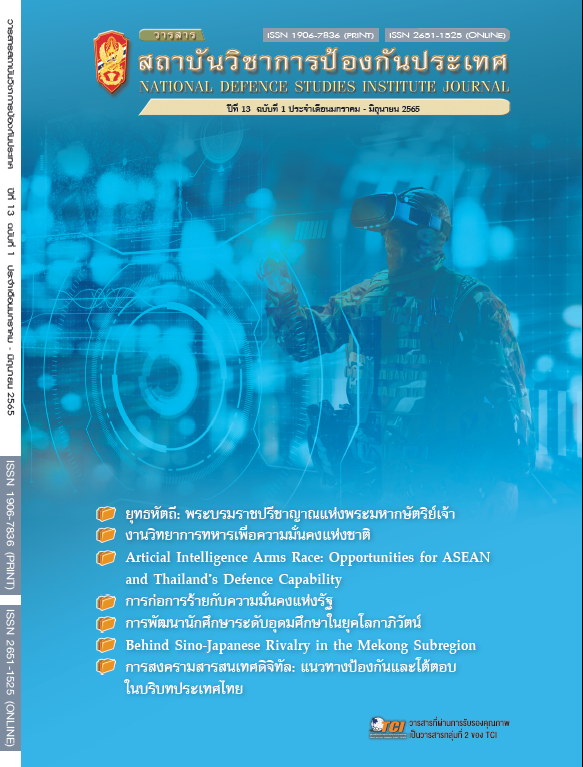Artificial Intelligence Arms Race: Opportunities for ASEAN and Thailand’s Defence Capability
Main Article Content
Abstract
This article is intended for 3 primary purposes: 1) to examine the competitiveness of the United States and China in the pursuit of global Artificial Intelligence (AI) whether it constitutes an arms race in accordance with the definition provided by Samuel Huntington; 2) to illustrate contemporary effects of the AI arms race on ASEAN military modernization; and 3) to analyze potential ways forward for Thai armed forces and defence industry in establishing AI capabilities. The study found that the competitive behaviour between the United States and China has constituted an AI arms race in accordance with Samuel Huntington’s definition of arms race. Both nations actively pursue to become a world’s leader in an AI related area, escalating mutual fears between each other as well as stimulating concerns globally. However, ASEAN nations, which geographically situate in the strategic arena of Asia Pacific, can benefit from the race. The rise of China and its expansion of influence within Southeast Asia provide an opportunity for ASEAN militaries to have access to affordable digital infrastructure as well as AI and AI-enabling technologies. The strategic partnership and alliance of the US in the region also bring in advanced technologies and assistance to the region. This study also identifies 4 necessary measures for the Thai military and defence industry sector to employ in the development of Thai defence AI capabilities. The first is to obtain essential knowledge base on AI through international relationship with the great powers. The second is to invest in defence digital infrastructure and set up necessary systems to support the implementation of AI into the services. The third is to start using AI in a tactical level, creating familiarization for tactical operators whilst lessening distrust between man and machine. The fourth is to investigate the human factor in a collaborative relationship between human and AI. These actions will help to accelerate the advancement of the forces and increase the defence industry’s capabilities to fulfill its domestic roles as well as to compete in the defence market.
Article Details

This work is licensed under a Creative Commons Attribution-NonCommercial-NoDerivatives 4.0 International License.
The articles, images, tables, graphs, written content, and opinions published in this journal are solely those of the authors and do not necessarily reflect the views or positions of the National Defence Studies Institute or its academic affiliates.
References
Apisitniran, L. (2019, 6 November). SCG joins forces with Chinese institute. Bangkok Post. Retrieved November 16, 2021 from https://www.bangkokpost.com/business/1788104/scg-joins-forceswith-chinese-institute
Association of Southeast Asian Nations. (2021). ASEAN-U.S. Leaders’ Statement on Digital Development.Retrieved November 16, 2021 from https://asean.org/wpcontent/uploads/2021/10/86.-ASEAN-U.S.-Leaders-Statement-on-Digital-Development.pdf
Putin: Leader in artificial intelligence will rule world. (2017, 4 September). Consumer News and
Business Channel [CNBC]. Retrieved September 4, 2017 from https://www.cnbc.com/2017/09/04/putin-leader-in-artificial-intelligence-will-rule-world.html
Haner, J., and Garcia, D. (2019). The artificial intelligence arms race: trends and world leaders in autonomous weapons development. Global Policy, 10(3), 331-337.
Huntington, S. P. (1958). Arms Races: Prerequisites And Results. Public Policy, 8, 41-86.
Janes. (2021a). Force for good: Southeast Asian countries seek enhanced UAV capabilities. Retrieved November 16, 2021 from https://customer.janes.com/Janes/Display/BSP_7799-JDW.
Janes. (2021b). US introduces trade bans on more Chinese firms. Retrieved November 16, 2021 from https://customer.janes.com/ Janes/Display/BSP_9650-JDIN.
Johnson, J. (2021). The end of military-techno Pax Americana? Washington’s strategic responses to Chinese AI-enabled military technology. The Pacific Review, 34(3), 351.
Lee, S. (2021). Explaining Contemporary Asian Military Modernization: The Myth of Asia’s Arms Race. Routledge.
National Security Commission on Artificial Intelligence. (2021). Final Report.
Jr Ng. (2021, 2 July). Thailand pursues new tactical-class UAV, based on a Chinese design. Asian Military Review. Retrieved November 16, 2021 from https://www.asianmilitaryreview.com/2021/ 07/thailand-pursues-new-tactical-class-uav-based-on-a-chinese-design
Phoonphongphiphat, A. (2020, 20 May). Thailand leads ASEAN in 5G rollout due to pandemic. Nekkei Asia, Retrieved November 17, 2021 from https://asia.nikkei.com/Spotlight/5G-networks/ Thailand-leads-ASEAN-in-5G-rollout-due-to-pandemic.
Scharre, P. (2019). Killer Apps: The Real Dangers of an Al Arms Race. Foreign Affairs, 98, 135-144.
Shen, H. (2018). Building a Digital Silk Road? Situating the Internet in China’s Belt and Road Initiative. International Journal of Communication, 12, 2684.


